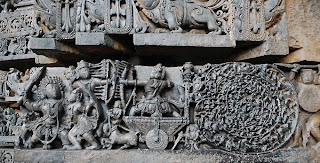
Taking into account that we did not have the technological advancements of today, the weapons that were used in the warfare played a vital role.The people who designed these weapons has to make them fatal as well as safeguarding.Some of the important weapons that were used include armors, bow and arrows, axes, daggers, khukri and many others..
ARMORS:

The warriors covered themselves in metal plates to protect their body. By the middle ages the armors had become sophisticated. The armors so covered the body that hardly any part was exposed. Helmets, breast plates, shields and limb protection shields were deviced for total protection during the war.Any armor had to be flexible to allow the free movement of the warrior and it had to be lightweight so that the warrior is not tired wearing it.
AXES:

An axe has a strong and sturdy handle with a blade at its one end. It can be a single blade or a double blade. The blade and the shaft both were metal but the shaft could be a wooden pole. The shaft was preferred long so as to maintain maximum distance between the head of the axe and the holders hands. The earliest axes of the stome age were probably not even hafted. The hafted axe belong to the mesolithic and neolithic age when they were used to fell trees. These axe blade were made by grinding the stone. Brich tar, raw hides and antler sleeve were used for hafting. The battle or T axe were a status symbol.
DAGGERS:

Daggers are short weapons with sharp edges. They are used for stabbing a person in war. Indian daggers are remarkably ornamented and are known for their good metal work. Medieval Daggers have been used for self defense, hunting and fighting. They have a religious significance for Indians.Two main types of daggers are Khukri and Katar.
SWORDS:

Swords, the gentleman of all weapons, were very prevalent during ancient ages. The sword fighters constituted the majority of the army.Indian swords are designed keeping in mind their unbreakability, rigidity and cutting power that blend together giving the sword, a very unique character. The value of an ideal sword is determined by type, style, condition, age, maker and many other factors. They are built with a strictly practical origin and elaborated far beyond the simple requirement of hard-wearing efficiency in slaughter.
HELMETS:

Helmets are considered as one of the most universal forms of armor specially designed to offer a defensive covering for the head, face and sometimes the neck from the cutting blows of swords, spears, arrows and other weapons. The typical helmet is a hardened-metal shell with an inner liner. In earlier times, the knight helmets were usually made of iron & leather and covered the entire head, with only a narrow opening in front for vision and breath.
WEAPONS AS DESCRIBED IN ANCIENT INDIAN LITERATURE:

The weapons mentioned above have been used by armies over time and they still do survive. The Indian literature has evidences that firearms and some of the scientifically sophisticated arms have been in use since a very long time in history.
It is possible that our ancestors could have had firearms, guns and cannons, explosives and what sounds like chemical, biological and even nuclear weapons.
Kautilya, the author of Ardhasashtra, describes in his work about agni-baan(which literally translates to FIRE_WEAPON) . He also mentions about agni-dharana, ksepyo-agni-yoga, and visvasaghati all of which are fire arms.The Visvasaghati-agni-yoga was virtually a bomb, which was made up of the mixture of the powder of kumbhi, lead, zinc, mixed with the charcoal and with oil wax and turpentine, burst and the fragments of metals were scattered in all directions. The agni-bana was a kind of an ancient shot-gun. From these evidences, it could be said that India was a fore runner in developing weapons.
